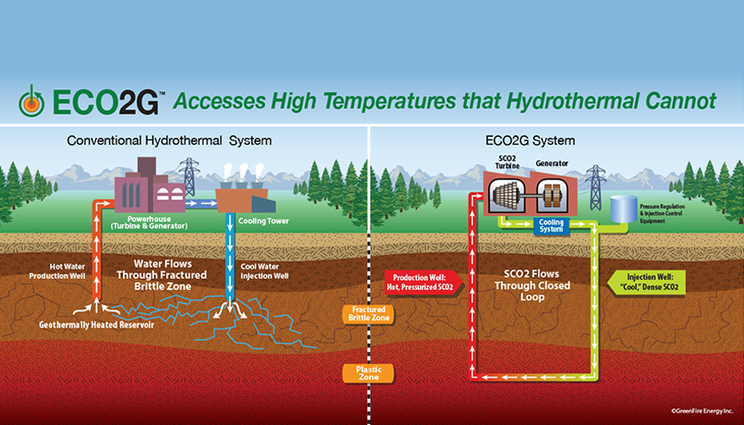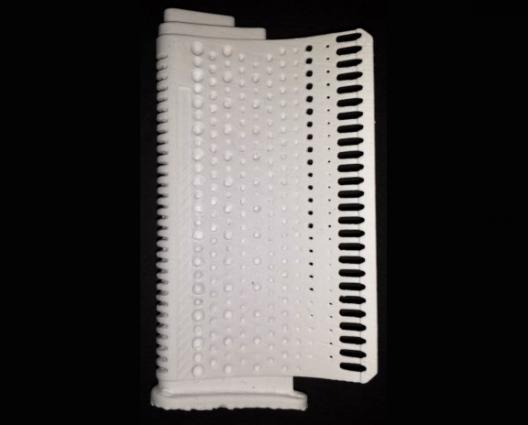Lab collaborates with small businesses in gas turbine manufacturing and geothermal projects
 (Download Image)
The diagram compares a conventional hydrothermal system and the ECO2G System, in which carbon dioxide is circulated through deep well bores to harvest geothermal energy. Lawrence Livermore National Laboratory is collaborating with GreenFire Energy on the project.
(Download Image)
The diagram compares a conventional hydrothermal system and the ECO2G System, in which carbon dioxide is circulated through deep well bores to harvest geothermal energy. Lawrence Livermore National Laboratory is collaborating with GreenFire Energy on the project.
Two small businesses working with Lawrence Livermore National Laboratory (LLNL) will receive more than $350,000 for expertise in advanced gas turbine manufacturing and geothermal engineering as part of the Department of Energy’s (DOE) Small Business Voucher (SBV) pilot.
With vouchers in hand, these businesses can better leverage the world-class capabilities of the department’s national laboratories and bring their next-generation clean energy technologies to the marketplace faster.
Specifically, LLNL scientists James Kelly and Jeff Haslam and Annemarie Meike from the Lab's Industrial Parnerships Office will help Renaissance Services Incorporated (RSI) with thermal process analysis and improvements for RSI’s additively manufactured ceramic cores, used in the casting of high efficiency turbine engine components.
Advanced turbine airfoil technologies depend upon complex cooling channels within the high-temperature blades and vanes to maintain temperatures within the safe operating range of metal alloys. These complex cooling channels require porous ceramic cores to form the internal pathways during the metal casting process. Understanding and improving the thermal processing of the ceramic cores is expected to improve production yield, which will reduce costs and significantly improve the commercial viability of this innovative manufacturing approach for turbine components.
In the other LLNL collaboration, scientists Joe Morris and Rick Ryerson will work with GreenFire Energy to develop a novel technology in which carbon dioxide is circulated through deep well bores to harvest geothermal energy.
The process requires drilling to depths below the brittle-ductile transition in crustal rocks, more than 5 kilometers. Completing the connection between the bottoms of two vertical wells at this depth is an engineering challenge. Creation of a fracture network connecting the two wells at depth is one possible solution. However, creating fractures in ductile rocks is difficult — by definition. Rocks that deform in ductile fashion within a particular P-T-strain rate regime may deform in brittle fashion at higher strain rates. Dynamic stimulation using energetic materials, e.g., propellants to explosives, may be useful in tailoring the strain rates in order to induce brittle behavior at the required depth.
With GreenFire, LLNL’s Computational Geosciences Group will undertake a computational effort to assess the feasibility of dynamic stimulation, determining the appropriate energy release characteristics and the spatial and temporal distribution of detonations necessary to enable GreenFire’s novel geothermal process.
DOE opened the first round of SBV, a technology-to-market lab impact pilot, in fall 2015. In SBV’s first round, 33 small businesses were selected to receive vouchers totaling $6.7 million. On Thursday, DOE awarded 43 projects totaling more than $8 million. To date, the DOE’s SBV pilot has connected 76 small businesses with the labs, totaling $15 million worth of vouchers.
With 23 million small businesses currently operating in the U.S., the pilot is heavily targeted in attracting companies that typically would not have access to the national labs’ scientific expertise and resources. The SBV pilot makes it possible to direct the power of the national laboratories toward specific problems identified by small businesses by pairing these companies with a national laboratory uniquely qualified to solve their challenges.
SBV is a collaborative, national effort that provides $20 million for U.S. companies to help improve industry awareness of national laboratory capabilities and provide small and mid-size businesses access to the resources available within the national laboratory system. Following open calls for "Requests for Assistance" (RFAs), businesses are competitively selected to work with a national lab to address their needs, and provided vouchers, worth up to $300,000 at the lab. SBV is part of DOE’s Office of Energy Efficiency and Renewable Energy (EERE) Technology-to-Market program.
Contact
 Anne M. Stark
Anne M. Stark
[email protected]
(925) 422-9799
Related Links
DOE Small Business Voucher ProgramOffice of Energy Efficiency and Renewable Energy (EERE)
Renaissance Services, Inc.
GreenFire Energy
Tags
Physical and Life SciencesFeatured Articles








